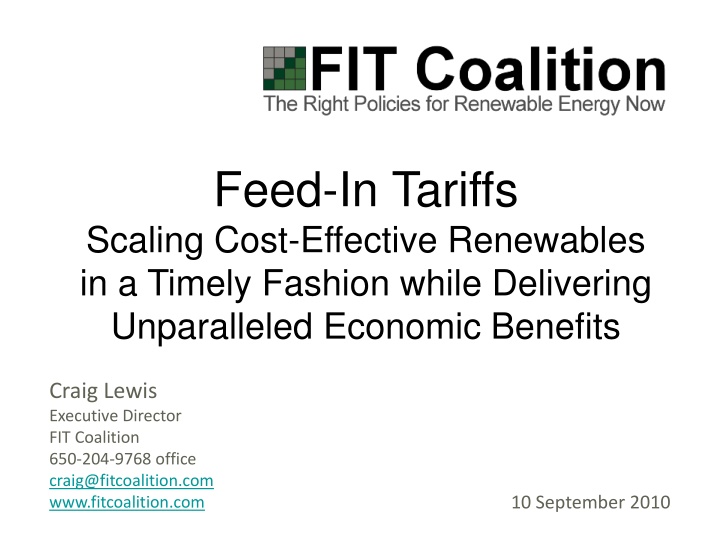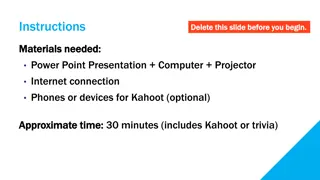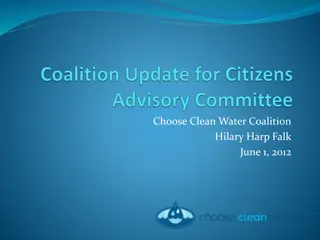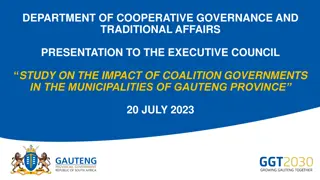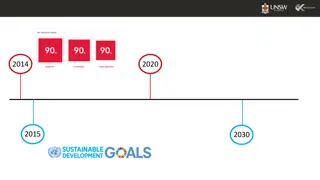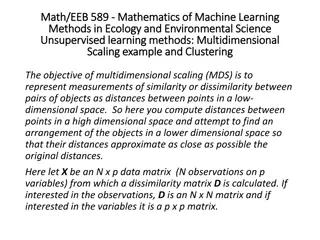Scaling Cost-Effective Renewables - FIT Coalition Overview
Implementing global best-practices for scaling cost-effective renewable energy in a timely manner. The FIT Coalition aims to deliver unparalleled economic benefits through Feed-In Tariffs (FITs), a powerful policy tool driving renewable energy deployment worldwide.
Download Presentation

Please find below an Image/Link to download the presentation.
The content on the website is provided AS IS for your information and personal use only. It may not be sold, licensed, or shared on other websites without obtaining consent from the author.If you encounter any issues during the download, it is possible that the publisher has removed the file from their server.
You are allowed to download the files provided on this website for personal or commercial use, subject to the condition that they are used lawfully. All files are the property of their respective owners.
The content on the website is provided AS IS for your information and personal use only. It may not be sold, licensed, or shared on other websites without obtaining consent from the author.
E N D
Presentation Transcript
Feed-In Tariffs Scaling Cost-Effective Renewables in a Timely Fashion while Delivering Unparalleled Economic Benefits Craig Lewis Executive Director FIT Coalition 650-204-9768 office craig@fitcoalition.com www.fitcoalition.com 10 September 2010
FIT Coalition Overview Mission To implement global best-practices for scaling cost-effective renewable energy in a timely and environmentally sustainable fashion Board of Advisors Jeff Anderson ED, Clean Economy Network Terry Tamminen Former Secretary of the CA EPA and Special Advisory to CA Governor Arnold Schwarzenegger Patricia Glaza ED, Clean Technology & Sustainable Industries Josh Becker General Partner, New Cycle Capital Jim Weldon CEO, Solar Junction Dan Kammen Distinguished Professor of Energy, UC Berkeley, Energy and Resources Group Jeff Brothers CEO, Sol Orchard R. James Woolsey Venture Partner, VantagePoint, Former Director, CIA John Geesman Former Commissioner of the California Energy Commission L. Hunter Lovins President, Natural Capitalism Solutions The Right Policies for Renewable Energy Now 2
Leading the World into the Future Solar, Wind, Electric Vehicles Energy Efficiency Nuclear, Biofuels, Other Fossil Fuels Solar Wind Storage Demand Response Electric Vehicles Nuclear Biofuels Other Fossil Fuels Economic sensibility National security Environmental sustainability The $6 trillion energy market will transition to Smart Energy The Right Policies for Renewable Energy Now 3
FITs Make the Solar Industry Source: Navigant Consulting 86% of the world s solar PV deployments in 2009 were driven by FITs, and the percentage is increasing The Right Policies for Renewable Energy Now 4
FIT Features & Benefits FIT Features Standard must-take contract for renewable energy Cost-based, technology-differentiated rates that are fixed for 20 years Fixed rates are set to attract deployments Degression reduces rates paid for new contracts based on cost reductions driven by economies-of-scale and learning Guaranteed interconnection for any project designed within the guidelines of the FIT program Renewable energy is purchased at wholesale with environmental attributes All environmental attributes, including RECs, are bundled with the energy sale FIT Benefits Simple, fair, and effective Solves all critical issues for deploying renewables: financing, procurement, and interconnection Most effective policy in the world for getting cost-effective renewables online in a timely fashion Avoids any type of solicitation process, including auctions, and the overwhelming parasitic costs and parasitic time associated with solicitations The Right Policies for Renewable Energy Now 5
Auctions Have Huge Failure Rates California RPS Project Failure Rate is ~97% FITs eliminate the massive parasitic costs associated with solicitations The Right Policies for Renewable Energy Now 6
FITs = Unparalled Market Mechanism Volume Standard Must-take Contract (SMC) S2 (FIT) Reduced developer risk Same price drives significantly more volume S1 (solicitation) D2 (FIT) D1 (solicitation) Price Supply and demand with solicitation process Supply and demand with a FIT program The Right Policies for Renewable Energy Now 7
Scaling the RPS Challenge 35.00% 30.00% 25.00% 20.00% 33% 15.00% 10.00% 20% 14.00% 13.90% 13.60% 13.20% 13.00% 12.70% 5.00% 0.00% 2003 2004 2005 2006 2007 2008 2010 2020 Sources: CPUC, CEC and UC Berkeley; Sep09. California needs the equivalent of 40GW of solar between today and 2020 The Right Policies for Renewable Energy Now 8
Californias RPS Reality Only 357 MW total renewables added in 2009, same as 2008 ~40 GW required >10 GW required 352 MW total renewables added in 2008 Sources: CPUC, CEC and UC Berkeley; Jul10. 2009 explained: California still needs 10x improvement to ~4 GW/year 9 The Right Policies for Renewable Energy Now
Deployments Drive Everything Developers Generation Projects Utilities Systems Technology Investors Equity Debt The entire renewable energy value chain depends on deployments The Right Policies for Renewable Energy Now 10
Volume Drives Learning Solar pricing is reduced by 20% for every doubling of deployed volume Si learning curve New technology learning curve Efficiency innovation The Right Policies for Renewable Energy Now 11
FITs Drive Solar Solar Markets: Germany vs California (RPS + CSI + other) 10000 10000 8000 8000 6000 6000 California California 4000 4000 Germany Germany 2000 2000 0 0 Sources: CPUC, CEC, SEIA and German equivalents. 2002 2002 2006 2006 2007 2007 2008 2008 2009 2009 Germany added17 times more solar than California last year! Even though California s solar resource is about 70% better!!! The Right Policies for Renewable Energy Now 12
German PV FIT = US$.12/kWh Most expensive German FIT rate is set for PV Germany s weighted average Wholesale Distributed Generation (WDG) PV rate is about US$0.30/kWh In CA, equivalent rate would be less than $0.10/kWh Tax credits in US reduce the German rate by 40% Investment Tax Credit (ITC) and Accelerated Depreciation Solar resource is 70% better in CA, which reduces German rate by more than an additional third Conservatively: 30 cents goes to 18 and then to 12 German PV rate of 30 cents is equivalent to less than 12 cents in California The Right Policies for Renewable Energy Now 13
US has tremendous solar resource relative to current leading solar markets The Right Policies for Renewable Energy Now Slide 14
FITs Drive All Renewables Development of electricity generation from renewable energy sources in Germany 1990 - 2009 120,000 Hydropower Wind energy EEG: Biomass * Photovoltaics January 2009 100,000 EEG: Electricity generation [GWh] August 2004 EEG: April 2000 80,000 Amendment to BauGB: November 1997 60,000 StrEG: 40,000 January 1991 - March 2000 20,000 0 1990 1991 1992 1993 1994 1995 1996 1997 1998 1999 2000 2001 2002 2003 2004 2005 2006 2007 2008 2009 * Solid, liquid, gaseous biomass, biogenic share of waste, landfill and sewage gas; Electricity from geothermal energy is not presented due to the negligible quantities of electricity produced; StrEG: Act on the Sale of Electricity to the Grid; BauGB: Construction Code; EEG: Renewable Energy Sources Act; Source: BMU-KI III 1 according to Working Group on Renewable Energies-Statistics (AGEE-Stat); Image: BMU / Christoph Edelhoff; all figures provisional The Right Policies for Renewable Energy Now 15
Get FIT to Win Municipalities Gainesville launched a Solar FIT in early-2009 Sacramento launched a massive FIT program in early-2010 San Antonio launched a Solar FIT in June 2010 Los Angeles expected to enact a major Solar FIT in coming months Many additional municipalities are in process States Vermont enacted the first statewide FIT in mid-2009 Ontario Canada launched a massive FIT in November 2009 Renewable Energy & Economic Stimulus Act (REESA FIT) in California Many additional states are in process National HR5883 (Inslee) introduced on 27 July 2010 www.fitcoalition.com The Right Policies for Renewable Energy Now 16
REESA FIT = Economic Win Report by UC Berkeley (Professor Dan Kammen and Max Wei) shows unparalleled economic boost to California from the REESA FIT as compared to the central station baseline case for achieving the 33% RPS by 2020 The REESA FIT will generate three times more jobs, which means an additional 28,000 direct jobs per year in California between now and 2020 With multiplier effects, stimulation of massive levels of indirect and induced jobs as well Investment and tax revenue increases are directly correlated to employment The REESA FIT drives three times more jobs in California than the baseline approach for fulfilling the 33% RPS The Right Policies for Renewable Energy Now 17
Ratepayers SAVE Money The REESA FIT in California delivers 5% in ratepayer savings while fulfilling the entire 33% RPS on schedule!!! Annual FIT rate degression (%) FiT Rate ($/kWh) Annual cap limit (%) Avoided Cost ($/kWh) Annual escalator for avoided cost (%) $ 0.16 2 $ 0.125 5 3 Total CA Electric Energy (GWh) FIT Rate ($/kWh) Cumulative Limit Quantity (GWh) FIT Fulfillment of RPS FIT Cost ($mil) Avoided Cost ($/kWh) Avoided Cost ($mil) Rates without FIT Rates with FIT Rate Differential baseline premium w/ FIT Year 2011 267,665 0.160 2.00% 5,353 2% 857 0.125 669 0.138 0.139 0.51% 2012 268,349 0.152 4.00% 10,734 4% 1,674 0.129 1,382 0.139 0.140 0.78% 2013 268,960 0.144 6.00% 16,138 6% 2,455 0.133 2,140 0.141 0.142 0.83% 2014 269,500 0.137 8.00% 21,560 8% 3,199 0.137 2,945 0.142 0.143 0.66% 2015 269,969 0.130 10.00% 26,997 10% 3,907 0.141 3,798 0.143 0.143 0.28% 2016 270,365 0.124 12.00% 32,444 12% 4,581 0.145 4,701 0.144 0.144 -0.31% 2017 270,690 0.118 14.00% 37,897 14% 5,223 0.149 5,656 0.145 0.144 -1.10% 2018 270,943 0.112 16.00% 43,351 16% 5,832 0.154 6,665 0.147 0.144 -2.09% 2019 271,124 0.106 18.00% 48,802 18% 6,411 0.158 7,728 0.148 0.143 -3.29% 2020 271,234 0.101 20.00% 54,247 20% 6,960 0.163 8,847 0.149 0.142 -4.66% Source: CPUC, FIT Coalition The Right Policies for Renewable Energy Now 18
Getting it Done Right, Finally Renewable Energy & Economic Stimulus Act (REESA) Makes the 33% RPS real, on schedule, and reduces rates for ratepayers Source: FIT Coalition The Right Policies for Renewable Energy Now 19
FITs are Refreshingly Simple FITs are the Easy Choice Parasitic Transaction Costs & Parasitic Transaction Time are Near-Zero Typical California paperwork for one project Typical Germany paperwork for one project Could be a 1kW-sized project, but maximum 1MW (via CSI program). Even more paperwork for California projects larger than 1MW (via RPS program). Could be a 1kW or 20MW-sized project, or bigger. Source: Gary Gerber, President of CalSEIA and Sun Light & Power, Jun09 Parasitics can easily add 10% on the ratepayer for California projects vs German ones The Right Policies for Renewable Energy Now 20
FITs Make the Solar Industry Backup The Right Policies for Renewable Energy Now 21
FIT Deliver on Renewables Goals Ontario Goal to Replace 100% of Coal Power by 2014 6 GW Coal power Note: The Canadian Province of Ontario had 31 GW of peak electric capacity in 2009. 6 GW of coal power on track to be replaced by renewables over 5 years 22 The Right Policies for Renewable Energy Now
HR5883 - National FIT Bill HR5883 introduced on 27 July 2010 Introduced by Congressman Inslee with four original co-sponsors: Reps Delahunt, Grijalva, Honda, and McCollum Modeled after successful European FIT programs Standard contract set by FERC Expedited priority interconnect (< 10kw, <2MW, SGIP) Cost-based rates originally set at 70th percentile of resource quality, then annual degression and/or analytical adjustments Target 8 percent return over 20 years Bonuses for congestion, peak, CHP, tribal Regional cost-sharing & reimbursement System benefits charge collected by national corporation Reimburse utility costs, including network upgrades and premiums over avoided cost Relief for energy intensive industries The Right Policies for Renewable Energy Now
Putting it Together in Palo Alto Renewable Procurement Necessary for Palo Alto's RPS Goals (Total Load = 1,000 GWh/yr) 400 PA RPS Goal: 33% (2015) California RPS: 33% (2020) 350 PA RPS Goal: 30% (2012) Difference to Palo Alto's RPS goals (GWh/yr) 300 250 Renewable Energy with present contracts (GWh/yr) GWh/yr 200 +10MW per year Solar FIT (starting 2021) 150 100 + 30MW per year Solar FIT (starting 2028) 50 0 2010 2015 2020 2025 2030 The Right Policies for Renewable Energy Now
Avoided Cost can be Surprising 25 The Right Policies for Renewable Energy Now
WDG FITs Deliver Trifecta Total Generation from Wind Power (2006) Total Jobs in RE Sector (2007) 300 Total Jobs in RE Sector ('000) 35 250 Total Generation (TWh) 30 200 25 150 20 15 100 10 50 5 N/A 0 0 UK Spain Italy Germany UK Spain Italy Germany Average per kWh Payment for Onshore Wind (2008) 25 (USD cents/kWh) Purchase Price 20 15 10 5 0 * Electricity price + Tradable Green Certificate (i.e. REC) Germany Spain UK* Italy* Countries Sources: NREL 2009; BMU 2008; EUROSTAT 2008; ISI, 2008; Fouquet, D. et al., 2008. The Right Policies for Renewable Energy Now 26
Key Definitions DG = Distributed Generation Retail DG (RDG) Behind-the-meter Net metered Wholesale DG (WDG) has some basic attributes Wholesale (all energy sold to the utility) 20MW-and-under Distribution-interconnected (close-to-load, but not behind-the-meter) PPA = Power Purchase Agreement Energy purchasing agreement between electricity generator and customer FIT = Feed-In Tariff Pre-defined, pre-approved PPAs between renewable energy generators and utilities Most effective policy in the world for getting cost-effective renewables online Simple, fair, and effective RPS = Renewables Portfolio Standard A renewables target: a percentage of total delivered energy by a specified date WDG market size 100 times larger than RDG market size The Right Policies for Renewable Energy Now 2 7
Project Size Market Segments Size Central Station, Transmission- Interconnected ~20 MW-and-larger Wholesale DG, Distribution- Interconnected <20 MW Retail DG <1 MW Segment Urban and Distribution grid Rural and Transmission grid 28 The Right Policies for Renewable Energy Now
Why California is Failing Program Effectiveness Gap in Programmatic Support CSI/SGIP Prog Net metering behind-the-meter RPS Program Large transmission- interconnected projects WDG 1MW-to-20MW RPS (small) AB1969 FIT SCE SPVP SCE Biomass Program 20 MW-and-above 1MW-and-under Project Size (MW, quasi-logarithmic) 1 20 1.5 10 0 The Right Policies for Renewable Energy Now 29
RDG/Net Metering Fails to Deliver MW RDG does not drive volume, nor does it satisfy RPS requirements The Right Policies for Renewable Energy Now 30
Central Station Fails to Deliver Shortest Conceivable Timeline for Transmission Build is 10 years Build-outs require 10 years IF everything goes smoothly no supply chain or financial barriers no environmental or litigation barriers CPUC estimates: For 33% RPS in 2020, 7 new transmission lines costing $12 Billion Source: CPUC-commissioned E3 analysis, Jan09 The Right Policies for Renewable Energy Now 31
Some Transmission is Impossible SMUD has been trying to get new transmission lines approved, but people are coming out in droves against it. We ll get two to three hundred people coming out in small towns of that same population. -- Obadiah Bartholomy, Sacramento Municipal Utility District The Right Policies for Renewable Energy Now 32
WDG: The Big Opportunity WDG = Wholesale Distributed Generation Wholesale (all energy sold to the utility) 20MW-and-under Distribution-interconnected (close-to-load, but not behind-the-meter) WDG provides significant Locational Benefits (LBs) value In CA - distribution-interconnected generation 35% more valuable than transmission-interconnected At the very least, WDG is worth 15% more that transmission- interconnected generation, because it avoids Transmission Access Charges (TACs) of ~1.5 cents/kWh that is paid to CAISO for energy off the transmission grid WDG potential: hundreds of GWs Whole CA system is 60GW at peak California Energy Commission RETI Phase 1B resource report identified 27.5GW of PV potential alone, looking only at 20MW projects on non- sensitive160 acre parcels that are adjacent to distribution substations Every successful FIT in the world is a WDG FIT The Right Policies for Renewable Energy Now 33
CEC: Unleash WDG Now Official CEC recommendation, released 1 Dec 08 The Right Policies for Renewable Energy Now 34
